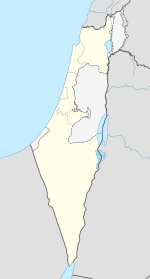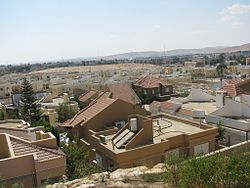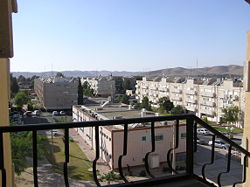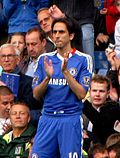- Dimona
-
Dimona Hebrew transcription(s) – Hebrew דִּימוֹנָה – ISO 259 Dimona Arabic transcription(s) – Arabic ديمونة 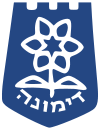
LogoCoordinates: 31°4′N 35°2′E / 31.067°N 35.033°ECoordinates: 31°4′N 35°2′E / 31.067°N 35.033°E District South Founded 1955 Government – Type City – Mayor Meir Cohen Area – Total 29,877 dunams (29.9 km2 / 11.5 sq mi) Population (2007) – Total 33,600 Dimona (Hebrew: דִּימוֹנָה) is an Israeli city in the Negev desert, 36 kilometres (22 mi) to the south of Beersheba and 35 kilometres (22 mi) west of the Dead Sea above the Arava valley in the Southern District of Israel. Its population at the end of 2007 was 33,600.[1]
Contents
Etymology
The city's name is derived from a biblical town, mentioned in Joshua 15:21-22.
History
Dimona was one of the development towns that created in the 1950s under the leadership of Israel's first Prime Minister, David Ben-Gurion. Dimona itself was conceived in 1953, and settled in 1955, mostly by new immigrants from Northern Africa, who also constructed the city's houses. The emblem of Dimona (as a local council), adopted 2 March 1961, appeared on a stamp issued on 24 March 1965.
When the Israeli nuclear program started later that decade, a location not far from the city was chosen for the Negev Nuclear Research Center due to its relative isolation in the desert and availability of housing.
In spite of a gradual decrease during the 1980s, the city's population began to grow once again with the beginning of the Russian immigration in the 1990s. Currently, Dimona is the third largest city in the Negev, with the population of 33,900.[citation needed]
On 4 February 2008 an Israeli woman was killed and 38 others injured in the town by a Palestinian suicide bomber (see Dimona bombing).
Population
Dimona is home to Israel's Black Hebrew community, governed by its founder and spiritual leader, Ben Ammi Ben-Israel.[2] The Black Hebrews number about 3000 in Dimona, with additional families in Arad, Mitzpe Ramon and the Tiberias area. Their official status in Israel was an ongoing issue for many years, but in May 1990, the issue was resolved with the issuing of first B/1 visas, and a year later, issuing of temporary residency. Status was extended to August 2003, when the Israeli Ministry of Interior granted permanent residency.
Economy
In the early 1980s, textile plants, such as Dimona Textiles Ltd., dominated the industrial landscape. Many plants have since closed. Dimona Silica Industries Ltd. manufactures precipitated silica and calcium carbonate fillers. About a third of the city's population works in industrial workplaces (chemical plants near the Dead Sea like the Dead Sea Works, high-tech companies and textile shops), and another third in the area of services. Due to the introduction of new technologies, many workers have been made redundant in the recent years, creating a total unemployment rate of about 10%. Dimona has taken part of Israel's solar transformation. The Rotem Industrial Complex outside of the city has dozens of solar mirrors that focus the sun's rays on a tower that in turn heats a water boiler to create steam, turning a turbine to create electricity. Luz II, Ltd. plans to use the solar array to test new technology for the three new solar plants to be built in California for Pacific Gas and Electric Company.[3][4][5]
Transportation
In the early 1950s, an extension to Dimona and south was constructed from the Railway to Beersheba, designed for freight traffic. A passenger service began in 2005, after pressure from Dimona's municipality. Dimona Railway Station is located in the southwestern part of the city. The main bus terminal is the Dimona Central Bus Station, with lines to Beersheba, Tel Aviv, Eilat, and nearby towns.
Notable residents
- Lucy Aharish, news presenter, reporter, and television host
- Jacques Amir (1933–2011), Knesset member
- Yossi Benayoun (born 1980), footballer [6]
- Kfir Edri (born 1976), footballer
Twin towns
Dimona is twinned with:
 Andernach, Rhineland-Palatinate, Germany (1975)
Andernach, Rhineland-Palatinate, Germany (1975)
Sources
- ^ "Table 3 - Population of Localities Numbering Above 1,000 Residents and Other Rural Population". Israel Central Bureau of Statistics. 2008-06-30. http://www.cbs.gov.il/population/new_2009/table3.pdf. Retrieved 2008-10-18.
- ^ "Ben Ammi". The African Hebrew Israelites of Jerusalem. http://www.africanhebrewisraelitesofjerusalem.com/ben_ammi.htm. Retrieved 2008-10-20.
- ^ Calif. solar power test begins — in Israeli desert, Associated Press, June 12, 2008; accessed December 23, 2008.
- ^ Israel site for California solar power test, Ari Rabinovitch, Reuters, June 11, 2008.
- ^ [1]
- ^ FC, Yossi Benayoun
External links
- The African Hebrew Israelites: New black civilisation in the promised land" article written by Lester Holloway, January 1, 2004, for Black Information Link
- Video of a 3D tour of Dimona
South District of Israel Cities 
Local councils Ar'arat an-Naqab · Hura · Kuseife · Lakiya · Lehavim · Meitar · Mitzpe Ramon · Omer · Shaqib al-Salam · Tel as-Sabi · YeruhamRegional councils Abu Basma · Be'er Tuvia · Bnei Shimon · Central Arava · Eshkol · Hevel Eilot · Hof Ashkelon · Lakhish · Merhavim · Ramat HaNegev · Sdot Negev (Azata) · Sha'ar HaNegev · Shafir · Tamar · YoavSee also Other sub-divisions: Center District · Haifa District · Jerusalem District · Judea and Samaria Area · North District · Tel Aviv DistrictCategories:- South District (Israel)
- Populated places established in 1955
- Cities in Israel
- Development towns
- Israeli nuclear development
Wikimedia Foundation. 2010.


